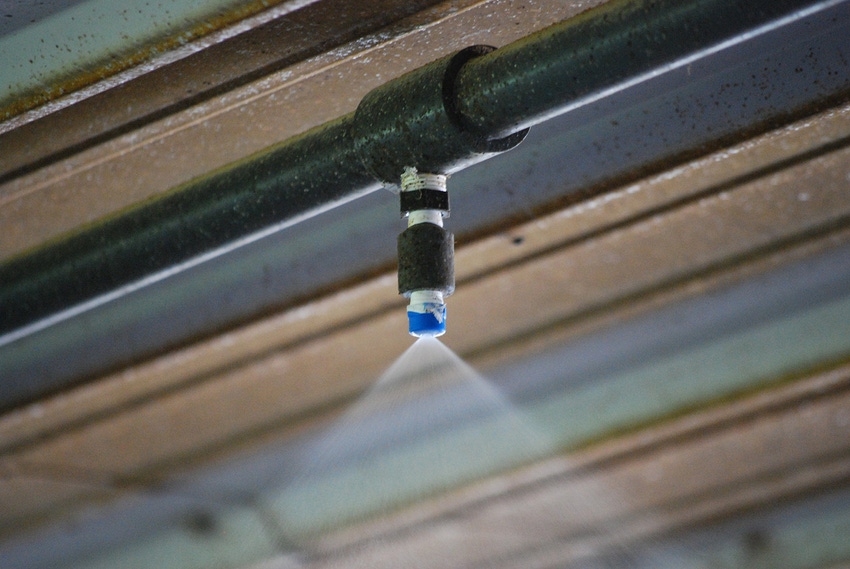As summer continues to ramp up and the negative economic impacts of heat stress well established, this is a perfect opportunity to dive into why we use current cooling systems and what can be checked to improve cooling.
June 21, 2017

By Brett C. Ramirez, Iowa State University Department of Agricultural and Biosystems Engineering Graduate Research Assistant
How do current cooling systems keep our pigs cool? Once equipped with an understanding of how these technologies work, we can make improved management decisions and reduce the impacts of heat stress. As summer continues to ramp up and the negative economic impacts of heat stress well established, this is a perfect opportunity to dive into why we use current cooling systems and what can be checked to improve cooling.
As briefly discussed in last month’s column, pigs have a variety of ways to lose their excess generated metabolic heat to the environment, but are generally regarded to be not very good at losing heat. Lacking the ability to sweat doesn’t help either.
With that in mind, we’ll go through the three methods of cooling commonly used for finishing pigs: elevated airspeeds, direct and indirect cooling. Elevated airspeeds (i.e., goal of tunnel ventilation or stir fans) to remove excess heat is effective if the air temperature is less than the pig’s skin temperature. Luckily, in the situations when the temperature gradient is small, the evaporation of water is available. When water changes phase, from a liquid to a vapor (i.e., evaporation), heat is needed. Heat is removed from a source to replace the heat removed when the water evaporates — then the temperature of the source is decreased. So, heat can be removed from the air passing through the evaporative cool pad or the pad itself (indirect cooling) or directly from the pig’s skin once wetted (direct cooling).
Indirect cooling
As outside air enters a cool pad, heat is removed from the wet pad and the air as the sprayed water evaporates. This causes the exiting air temperature to decrease (since heat was removed for evaporation) and the moisture in the air to increase. The pigs then experience cooler, but more humid, air. What is important? Outside air temperature and moisture, pad thickness, pad face velocity and room airspeed (more on that later). The amount of heat that can be removed depends on how much capacity that incoming outside air has to hold moisture. For example, assuming a 75% efficient cool pad (which is fairly common), air at 90 degrees F, 20% (relative humidity) can be cooled to about 67 degrees F, 75%. While air at 90 degrees F, 60% can only be cooled to 81 degrees F, 90%. Further, pad thickness and face velocity are important factors in efficiency. High pad airspeeds reduce pad contact time decreasing efficiency and potentially increasing fan energy due to higher operating static pressure.
Direct cooling
In contrast to cool cells, heat is removed directly from the pig. As air moves over wetted skin, the water evaporates taking heat away from the pig. What is important? Air temperature and moisture, wetted area and room airspeed (more on that later). Just like in indirect cooling, the air must be able to hold the additional moisture from evaporation. Further, the pig can lose more heat if more of its skin is wet. Verifying sprinklers have sufficient pressure and large droplets that cover a large portion of the pen (so pigs can access it) is necessary.
Room airspeed
Airspeed is a critical parameter determining how much heat can be removed, and when coupled with a cooling method, becomes very powerful. First without cooling — as mentioned before, a temperature gradient must exist; hence, as the air temperature approaches the skin temperature of the pig (which is roughly 90 degrees F in warm/hot conditions), very little to no heat can be removed (regardless of airspeed). As airspeed increases, more heat can be removed, but this diminishes quickly past about 400 fpm. The pig’s orientation within the flow (i.e., body perpendicular or parallel) also plays a role on how much heat the pig can release. This allows them to self-regulate based on their needs.
Airspeed with indirect cooling
The air temperature is cooler but with more moisture, so if we also increase the airspeed with this cooler air, we can remove more heat (think wind-chill). We have to make sure the pig is losing enough heat to this larger temperature gradient and does not need to use additional physiological responses that require evaporation (e.g., respiration) because that cool and moist air may not have the capacity to hold more water vapor. The key is to not under size fans just because the air is cooler. Also, not enough fan capacity still leads to heat accumulation in the room, even if the air temperature is cooler.
Airspeed with direct cooling
Elevated airspeeds are essential to increase the evaporation rate of water on the pigs and subsequently the heat loss. Sprinklers with tunnel airspeeds combined are very powerful at removing heat. It can sometimes be too powerful depending on the size of the pig, airspeed and temperature (think getting out of shower and standing in front of a fan). Insufficient airspeeds can lead to slow water evaporation and if the pigs are not drying, they are not losing heat. It is important to match sprinkler off time with how long it takes the water to evaporate from their skin. Sprinkler on time is dictated by the time required to properly cover the pigs with surface water and once established, rarely needs to be changed.
The evaporation of water is a powerful and relatively inexpensive method for cooling pigs. Whether it be taken advantage of by indirect cooling (i.e., evaporative cool cells) or direct cooling (i.e., sprinkling), it can help reduce the impacts of heat stress. Our discussions will resume in August. Stay tuned!
You May Also Like



